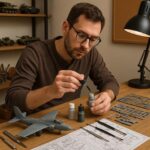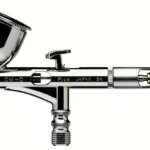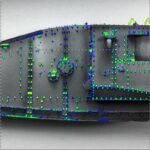
From perfect hair‑thickness layers to the right thinners—and why professional airbrushers leave levelling additives behind.
Backstory: From Frustration to Finish-Line Precision
Every seasoned scale modeller has been there: you lay down a beautiful base coat, only to return minutes later and watch your final lacquer pass crinkle, blister, or develop an unexpected texture. You followed all the typical advice—“light coats,” “lower pressure,” “good thinner”—yet something still went wrong. That’s because vague terms and inconsistent techniques often overlook the single most critical factor: film thickness, and how solvent‑based lacquers off-gas.
This article was born from years of frustration, experimentation, and careful observation—eventually uncovering that paint thickness control, not pressure or brand alone, is the root of success. To bring clarity to this abstract concept, we use physical, intuitive visual references:
- A single strand of human hair (about 70–100 μm) becomes your unit of measurement for a “wet” lacquer coat.
- A strip of Tamiya masking tape (~80 μm thick) provides a real-world comparison to judge your airbrush passes.
By reframing your spray passes as measurable “tape‑layers” or “hair‑levels” of film, this guide offers a precision-based method for gauging lacquer thickness, improving atomization, and eliminating off-gassing disasters.
Whether you’re a beginner trying to avoid the heartbreak of solvent blisters or an advanced modeller fine-tuning for flawless metallics, this guide will elevate your process with exact thinning ratios, MAC valve control, and a new way of visualizing how much paint is truly “too much.”
Achieving a flawless finish on your scale models is as much science as it is art. In this comprehensive guide, you’ll discover how visualizing wet film in “hair‑levels” helps you avoid pinholes and blisters, why precise thinning ratios (from 3:1 to 9:1) are critical for smooth off‑gassing, and how a MAC (Modulating Air Control) valve delivers the consistent airflow needed for razor‑sharp detail work. We’ll explore beginner‑friendly levelling thinners—Mr. Color, Tamiya Retarder, and Real Colours High Compatibility—and reveal why advanced modellers eventually paint without them. Finally, learn why Mr. Rapid Thinner is the go‑to choice for metallics and matt finishes, keeping pigments perfectly suspended and flat lacquers crisp. Whether you’re just starting or refining pro‑level technique, this article equips you with every tool to elevate your lacquer finishes from amateur to museum‑quality.

Using Human Hair as a Visual Reference for Wet Paint Thickness
When working with airbrushed lacquers, especially in scale modelling where precision matters, it can be difficult to visualize just how thin each paint layer should be. This is where human hair becomes a surprisingly helpful reference. With an average diameter of about 75 μm (microns), a single strand of hair offers a relatable, real-world comparison. Since wet lacquer typically goes down at around 80–100 μm per coat (before drying to a thinner layer), thinking of each pass as roughly the thickness of a human hair—or just slightly more—gives you a tangible benchmark for controlling paint application.
Human hair varies quite a bit, but a useful nominal value is 75 μm per hair (range 17–181 μm) Wikipedia. Solvent‐based lacquer typically lays down a wet film of roughly 3–5× its eventual dry film thickness. If your target dry film is 20 μm (a common build per coat), you end up with:
Hair‐levels ≈ (80–100 μm) ÷ 75 μm ≈ 1.0–1.3 hairs
Wet film thickness (WFT) ≈ 80–100 μm per coat
Visualize Wet Film as “Paper‑Layers” (instead of Hair‑Levels)
Rather than comparing paint films to human hairs, think in terms of standard copy‑paper thickness—about 100 μm per sheet:
- ≤ 1 sheet (≤ 100 μm WFT) per wet coat: solvents escape smoothly, with minimal risk of trapping.
- 1–2 sheets (100–200 μm WFT) cumulative: you enter the danger zone for pinholing or early “orange peel.”
- > 2 sheets (> 200 μm WFT) cumulative: solvent vapours struggle to migrate, leading to blistering or popcorn defects.
- Dry Film vs. Paper: Once fully cured, a lacquer coat typically measures 15–20 μm—only about ⅕ of a sheet of paper—highlighting how thin and precise your final finish really is.
Visualize Wet Film as “Tape‑Layers” (using Tamiya Masking Tape)
Rather than paper, think in terms of a single strip of Tamiya masking tape—approximately 80 μm thick per layer:
- ≤ 1 tape (≤ 80 μm WFT) per wet coat: solvents escape smoothly, with minimal risk of trapping.
- 1–2 tapes (80–160 μm WFT) cumulative: you enter the danger zone for pinholing or early “orange peel.”
- > 2 tapes (> 160 μm WFT) cumulative: solvent vapours struggle to migrate, leading to blistering or popcorn defects.
- Dry Film vs. Tape: Once fully cured, a lacquer coat typically measures 15–20 μm—only about ¼ of a Tamiya tape layer—underscoring how fine and precise your final finish truly is.

Solvent‑Based Lacquer Off‑Gassing & Outgassing Glossary
- Pinholing
Tiny, crater‑like holes in the cured film were caused by solvent vapour erupting through before the surface skin had fully set. - Blistering
Raised bubbles or “blisters” where solvent vapour accumulates under the surface, lifting the cured lacquer film and often popping to leave rough spots. - Popcorning (Solvent Pop)
A severe form of pinholing in which numerous small bubbles burst simultaneously, resembling popcorn; typically the result of very thick wet films or rapid recoating. - Cratering
Larger, irregular depressions or “craters” in the finish where solvent pockets collapse after bursting, leaving visible divots. - Orange Peel
A textured, dimpled surface that resembles the skin of an orange—often an early warning of uneven solvent evaporation and surface‑skin/inner‑core curing differences. - Fish‑Eyes
Circular spots where the lacquer retracts from the substrate, exposing the layer beneath, while often caused by contamination, rapid outgassing can exacerbate their formation at edges or high‑build zones. - Lifting/Crawling
The recoating lacquer pulls away from an uncured or partially cured layer below, driven by solvent trapped at the interface; appears as bare patches or shrunken film. - Solvent Blush
A cloudy, matte haze on the surface caused by condensed solvent vapour reabsorbing into the lacquer before it cures, often found in high‑humidity or low‑temperature environments. - Sinking
Localized depressions where the film thins and solvents drain or collect before evaporating, leaving “low spots” in the finish. - Vapor Eruption
The dramatic release of trapped solvent as a visible mist or spray through the film, typically when recoating too soon or applying very heavy wet coats.
Use this glossary to diagnose and communicate precisely about off‑gassing defects—so you can adjust your thinning ratios, flash‑off times, and application technique for truly flawless lacquer finishes.

Why off‑gassing “popcorn” occurs
Solvent vapours must escape through the paint film as it cures. When you exceed a critical cumulative wet thickness, the still‑liquid under‑layers trap solvent beneath, leading to tiny blister “popcorn” in the top coat.
Empirical experience and technical guides (e.g. conformal coatings run 25–127 μm WFT; above that, solvent entrapment climbs steeply (techspray.com) suggest:
- Below ~1 hair (≤ 75 μm WFT) per wet pass: solvent release is smooth, risk is minimal.
- Around 1–2 hairs (75–150 μm WFT) cumulative: you enter the danger zone. You’ll begin to see tiny pinholes or a slightly “orange‑peel” texture as off‑gassing struggles to get out.
- Above ~2 hairs (> 150 μm WFT) cumulative: trapped solvents form visible blisters, runs and adhesion problems.
Practical takeaway for model‐scale spraying
- Keep each wet pass under ~1 hair thickness (~75 μm).
- Flash off (let solvents evaporate until the surface is just tack‑free) before re‑coating; this usually means waiting 5–15 minutes, depending on temperature/reducer.
- If you need more build, do multiple thin passes rather than a few heavy ones—aiming for no more than 1 hair per wet coat, and avoid stacking more than 2 hair’s worth total before allowing a full cure.
By visualizing your wet spray as “hair‑layers,” you can literally count how many hair‑thicknesses you’re laying down and stop before solvent traps become a problem.
Uneven Off‑Gassing in Extra‑Thick Coats (> 2 Hair‐Levels)
When you build up more than roughly 2 hairs’ worth of wet lacquer (~ 150 μm+) in a single pass or before a full cure, you set the stage for highly uneven solvent escape:
- Surface vs. Body Solvent Gradient
- The very top of the wet film is closest to air, so its solvents begin evaporating immediately once the spray gun moves on.
- Deeper down, solvent molecules must diffuse through an increasingly viscous and densifying polymer network. That means the interior stays “wet” far longer than the skin‐deep layer.
- Airbrushing Across Multiple Sections
- As you work across a large surface, the first areas you painted will already be shedding solvent (and tackifying) while you continue to lay fresh, thick, wet layers elsewhere.
- By the time you return with your airbrush to add more lacquer, those early zones have formed a semi‐solid skin. Any new solvent from subsequent passes now tries to escape through this hardened layer, trapping itself in the underlying paint.
- The “Perfect Storm”
- Returning for another heavy pass on an area that’s already “skinned over” creates internal pressure pockets.
- These pockets rupture the brittle surface as tiny pinholes or larger blisters when enough vapour accumulates, often just minutes after that final wet coat.
How to Avoid This Disaster
- Sectional Thin‐Pass Strategy
Work in small, contiguous zones no larger than your gun’s flash‐off window (typically a few square inches). This keeps all areas in roughly the same curing phase. - Frequent Flash‐Off Between Passes
Even if you’re building toward a thick finish, pause after each light pass (≤ 1 hair) for at least its tack‐free time. Resist the urge to “fill in” immediately. - Monitor Surface “Give”
Gently touch a test edge: if it leaves any residue or feels sticky, wait longer before recoating. If it’s hard but cold‐to‐the‐touch, solvent is likely trapped—better to let it rest fully before proceeding.
By recognizing how a hardened skin can outpace the solvent‐rich core—especially when you circle back with more wet paint—you can plan your airbrushing sequence to maintain uniform curing and avoid those nasty pinholes or blisters.
Proper Thinning Ratios and the Role of MAC Valves in Scale Modelling
Why Thinning Ratios Matter for Scale Modelling Lacquers
In scale modelling, control and finesse are paramount. Using the correct thinning ratio ensures that each hair‑level coat dries evenly and off‑gasses properly, preventing pinholes and blisters on tiny details:
- Common Scale‑Model Ratios
- 3:1 (thinner : paint) – For heavily pigmented colours or metallic base coats; slows cure enough to let pigments settle evenly without clogging fine nozzles.
- 4:1 to 6:1 – The sweet spot for most lacquer paints on 1/35 to 1/72 scales; fluid enough for smooth, narrow spray lines yet viscous enough to build colour opacity in two thin passes.
- 7:1 to 9:1 – Ideal for clear coats or micro‑glazes on fine details, where you need rapid solvent release to avoid softening adjacent decals or masking edges.
- Off‑Gassing Benefits on Small Parts
- Low Viscosity Layers let solvents diffuse quickly through the film—even in recesses and panel lines—so you can flash‑off without waiting ages.
- Consistent Wet Film Thickness keeps each pass under ~75 μm (1 hair), letting you build up colour without exceeding the 2‑hair danger zone.
- Uniform Cure Across Tiny Surfaces prevents localized soft spots that cause detail loss or “orange peel” on curves and rivets.

📝 Tech Note: Thinning Ratios Are Just Baselines!
- 🎨 Brand Variability
Every lacquer formulation is unique. Pigment load, resin type, and solvent blends differ from Mr. Color to Tamiya to Real Colours. What works perfectly for one brand may be too thin—or too thick—for another. - ⚖️ Ratios Are Starting Points
The 3:1, 4:1–6:1, and 7:1–9:1 thinner : paint guidelines are baselines, not hard rules. Use them to get in the ballpark, then fine‑tune:- Test on a scrap piece 🎯
- Adjust by small increments (e.g., 0.5 parts thinner) 🔄
- Observe atomization & film thickness 🔍
- 👩🔧 Match Your Skill Level
- Beginners may prefer thicker mixes (lower thinner : paint) for more forgiving flow and slower cure.
- Advanced painters can push higher thinning ratios for ultra‑fine detail, relying on perfect trigger control and airflow.
- 🛠️ Equipment Matters
- Airbrush nozzle size, compressor output, and MAC valve calibration all affect ideal viscosity.
- What sprays beautifully through a 0.2 mm needle at 1.5 bar may clog a 0.3 mm setup—or vice versa.
- 🚀 Continuous Improvement
Keep a log of your personal “sweet spot” mixes for each brand/airbrush combo. Over time, you’ll dial in your custom ratios faster than ever!
💡Remember: Thinning is as much art as science. Start with the baseline, then adjust until your spray pattern, film build, and off‑gassing behavior sing in harmony!

 and you’ll notice the texture of the styrene test card still visible — a true testament to ultra-high paint dilution and the legendary MAC Valve magic!
and you’ll notice the texture of the styrene test card still visible — a true testament to ultra-high paint dilution and the legendary MAC Valve magic! 

Why a MAC Valve Is Indispensable for Scale Modelling
When you’re painting a model’s turret, cockpit interior, or landing‑gear struts, you need rock‑steady airflow. A MAC (Modulating Air Control) Valve lets you fine‑tune that airflow in real time—a far superior method to throttling your compressor:
- Manual Calibration for Optimum Airflow
- Rather than specifying target air pressures at the valve, you adjust the MAC valve by feel: tune the airflow to suit your chosen thinning ratio (3:1 up to 9:1).
- This ensures perfect atomization—tiny, uniform droplets—so even the most intricate stencil or camo pattern on a 1 mm‑wide panel line is crisp and clean.
- Steady Flow Prevents Sputter on Miniature Parts
- Turning down compressor pressure directly often causes lags that show up as spitting—devastating when you’re airbrushing minute details.
- The MAC valve’s rapid modulation delivers exactly the air volume you need, when you need it, for a flawless, even coat every pass.
- Improved Flash‑Off Without Cooling
- Because the compressor operates at its optimal setting, the airstream remains warm and dry, accelerating solvent evaporation on very small surfaces.
- You can even “pulse” the valve closed for a moment between strokes—letting solvents escape—then reopen it at the same calibrated airflow for your next fine detail pass.

Scale‑Model Workflow Example:
- Thin your lacquer according to your needs (3:1 for base coats, up to 9:1 for clear glazes).
- Set your compressor to deliver approximately 1.5 bar at the hose.
- Manually calibrate your MAC valve by spraying a test panel: adjust until atomization is smooth and droplet size is correct for your thinning ratio.
- Spray consistent, hair‑level passes on wheels, tracks, and tools—pausing briefly (via the MAC valve) before each new area to flash off solvents.
By pairing scale‑model‑optimized thinning ratios with the precise, manually calibrated airflow of a MAC valve, you’ll achieve ultra‑smooth, detail‑preserving lacquer finishes—no pinholes, no softening of decals, just museum‑quality results.
Recommended Levelling Thinners for Inexperienced Airbrush Users
Beginners often struggle with uneven flow, orange peel, or premature drying in fine detail work. Levelling thinners add surfactants and retarders that help the paint self‑level and extend open time—making smooth, hair‑level coats easier to achieve.
- Mr. Color Levelling Thinner (🟡 label)
- Self-levelling Additives: Reduces surface tension, helping paint flow out uniformly after each pass.
- Moderate Retarder: Slows solvent evaporation just enough to prevent “fisheye” or dry‑tips without risking sagging.
- Compatibility: Designed specifically for Mr. Color lacquers, so you’ll get consistent gloss and adhesion.
- Tamiya Lacquer Thinner – Retarder Type (🟧 cap)
- High Retarder Content: Gives extra open‑time for working small stencils or camo masks on 1/72 and 1/144 scales.
- Fine Atomization: Balances viscosity so that even with lower compressor pressures (around 1.5 bar), you still get a smooth spray.
- User‑Friendly: Helps hide minor technique issues—if your trigger release is a bit abrupt, the paint still settles out nicely.
- Real Colours High Compatibility Thinner (🟦 cap)
- Broad Brand Support: Works not only with Real Colours lacquers but also many third‑party and vintage formulations.
- Self-levelling Polymers: Actively smooth out brushstrokes and airbrush passes, making them perfect for those just dialling in their MAC valve feel.
- Fast Flash‑Off: Despite its levelling properties, it won’t over‑soften decals or masking edges when used at 4:1–6:1 ratios.

When Advanced Modellers Can Forgo Levelling Thinners
Experienced airbrushers who have mastered MAC‑valve calibration, thinning ratios, and trigger control can often skip levelling thinners altogether:
- Precise MAC Valve Flow Control
- By exactly adjusting airflow to match the paint’s viscosity, advanced users maintain perfect atomization without the need for extra surfactants.
- Optimized Thinning Ratios
- Knowing that 3:1–9:1 thinner : paint ratios yield predictable WFT and solvent release, they can rely on pure lacquer and standard thinner.
- Flawless Application Technique
- With steady hand speed, consistent trigger pressure, and strategic flash‑off pulses, they avoid the edge‑drying and orange‑peel issues that levelling thinners mitigate.
In short, levelling thinners are a crutch that accelerates learning and masks minor technique flaws. Once you’ve internalized airflow feeling, thinning precision, and application timing—especially on micro‑scale details—you’ll achieve perfectly flat, pinhole‑free finishes using only hobby standard lacquer thinners; Mr.COLOR THINNER (blue label), TAMIYA LACQUER THINNER (🟨 cap) and REAL COLORS HIGH COMPATIBILITY THINNER (🟦 cap).
Optimal Thinner for Metallics and Flat‑Finish Lacquers: Mr. Rapid Thinner (🔴 label)
Metallic and flat‑finish lacquers have unique requirements—metallic pigments must remain uniformly suspended and aligned to catch the light correctly, while matt formulations need rapid solvent release without surface defects. Mr. Rapid Thinner excels in both:
- Enhanced Pigment Suspension
- Low Surface Tension, No Surfactants: Unlike levelling thinners, Mr. Rapid uses solvating agents that keep aluminum and stainless‑steel flakes evenly dispersed without relying on surfactants that can cause pigment clumping.
- Rapid Re‑Suspension: If any settling occurs during a break, a quick stir and spray cycle easily re‑distributes the flakes, ensuring a consistent metal‑flake orientation.
- Fast Flash‑Off for Flat Finishes
- Ultra‑Fast Evaporation: Flat lacquers benefit from shorter open‑times to avoid dust nibs and “lapping,” and Mr. Rapid’s solvent blend evaporates cleanly without leaving a glossy halo.
- Minimal Retarder Content: Prevents the flat lacquer’s matting agents from over‑softening or migrating, preserving the intended low‑sheen surface.
- Why Levelling Thinners Hurt Metallics
- Surfactant‑Driven Settling: Levelling thinners add surfactants that reduce surface tension too much, causing metal flakes to “blanket” together—resulting in a uniform mirror‑like patch (“tin foil” effect) rather than a dynamic metallic shimmer.
- Extended Open‑Time Issues: The added retarders let pigments settle out of suspension before the film sets, producing streaks, pinholing, or areas of bare basecoat.
Best Practice Workflow for Metallics & Flats:
- Thin metallic or flat lacquers with Mr. Rapid at 3:1 to 4:1 thinner : paint for optimum flake flow or matt build.
- Stir the cup gently just before spraying to lift any settled flakes.
- Spray hair‑level passes, letting the first pass flash‑off briefly (10–20 s) to lock flakes in their initial orientation.
- Build additional coats as needed, always giving each layer just enough time to become tack‑free—this locks in pigment alignment or flat‑finish smoothness without agitating the suspension.
By choosing Mr. Rapid Thinner for metallics and flat lacquers, you ensure that pigments stay in suspension, flakes align correctly, and matting agents set cleanly—avoiding the pitfalls of levelling thinners and achieving true-to-intent finishes.
📝⚠️ TechNote: Enamel Acrylic Paints – require their own dedicated thinner (🟦 cap).

🗝️ Key Takeaways
- Visualize Wet Film as “Hair‑Levels”
- Aim for ≤ 1 hair (~75 μm) per wet coat; avoid exceeding 2 hairs total to prevent trapped vapour and defects.
- Optimal Thinning Ratios (Thinner : Paint)
- 3:1 for heavy base coats or metallics
- 4:1–6:1 for general color build on 1/35–1/72 scale
- 7:1–9:1 for clear coats, glazes, and fine detail
- MAC Valve Control
- Manually calibrate airflow (not pressure) to match the thinning ratio for perfect atomization and steady flow.
- Use brief valve pulses between passes to flash‑off solvents without cooling the airstream.
- Beginner‑Friendly Levelling Thinners
- Mr. Color Levelling Thinner, Tamiya Retarder, Real Colours High Compatibility
- Self-levelling additives and retarders mask technique flaws and extend open time.
- Advanced Modelling Technique
- Mastery of airflow, thinning, and trigger control lets you skip levelling thinners and rely on standard lacquers.
- Mr. Rapid Thinner for Metallics & Flats
- Keeps metal flakes suspended and aligned; fast‑evaporating blend preserves matte agents.
- Avoid levelling thinners with metallics to prevent pigment clumping and “tin‑foil” effects.
- Common Off‑Gassing Defects
- Pinholing, blistering, popcorning, cratering, orange‑peel, fish‑eyes, crawling, solvent blush, sinking, vapour eruption
Use these distilled principles—coat thickness, mix ratios, airflow mastery, and the right thinner—to achieve flawless, museum‑quality lacquer finishes on your scale models.

🛠️ Tech Note Preamble: The “Tape-Edge” Litmus Test
Despite the availability of precision methods—measuring hair-thin layers, tracking microns, consulting MAC-valve airflow charts, and logging thinning ratios—most scale modellers prefer a simpler, more tactile gauge of wet film thickness: a swath of lacquer laid between two strips of masking tape. Here’s why this no-frills method works and how to use it as your impromptu quality check:
- Setup Is Effortless
- Affix two parallel strips of standard Tamiya masking tape on your test panel, spaced a few millimetres apart.
- Spray a single pass of your mixed lacquer directly between the tape walls—no callipers, gauges, or microscope needed.
- The Tac-Free Check
- Wait until the lacquer is tack-free (no longer sticky to a light fingertip touch).
- Carefully peel away both tape strips.
- Feeling the Paint Ledge
- Gently run your fingertip across the gap where the tape was.
- If you feel a pronounced ledge—an obvious paint ridge—your wet film was too thick. This edge is your early warning of potential pinholes, blistering, or orange-peel defects.
- Refinement by Iteration
- Rinse and Repeat: Adjust your mix (more thinner, lighter trigger pull, or faster pass), then re-spray between fresh tape strips.
- With each cycle, aim to reduce the ledge’s prominence. When the edge becomes hardly detectable, you’re reliably laying down coats at true micron-level thickness.
- Why It Works
- This tactile feedback loop instantly correlates your technique—thinning ratio, airbrush speed, and airflow modulation—with real-world film thickness.
- It trains your muscle memory: you learn exactly how a “correct” pass feels against the tape guides, internalizing that ideal wet-film thickness for future freehand work.
By embracing this analog litmus test, you gain an intuitive “feel” for microscopic control—no special tools required. Use it as a quick pre-session warm-up or a troubleshooting drill whenever off-gassing blemishes threaten your final finish. Over time, the tape-edge test hones your technique so thoroughly that your eye—and your fingertip—becomes the ultimate thickness gauge.


James (Doc) Wooldridge
James is a dedicated scale modeller, researcher, author, and content creator with a passion for precision and historical accuracy. Renowned for his super-detailing techniques and authentic colour schemes, he’s been featured on Scalemates and in Google Featured Snippets.
An active contributor to a major scale modelling Facebook community and producer of video tutorials, James combines clear, encouraging instruction with professional-grade photography to inspire modellers at every level.
Guided by a philosophy of clarity, encouragement, and continuous learning, he empowers hobbyists to build both skill and confidence.
As a founding executive of KSM–IPMS and Kawartha Scale Modellers, James continues to lead and innovate within the hobby.💡📏 📐📱🎬 📷 🎥









